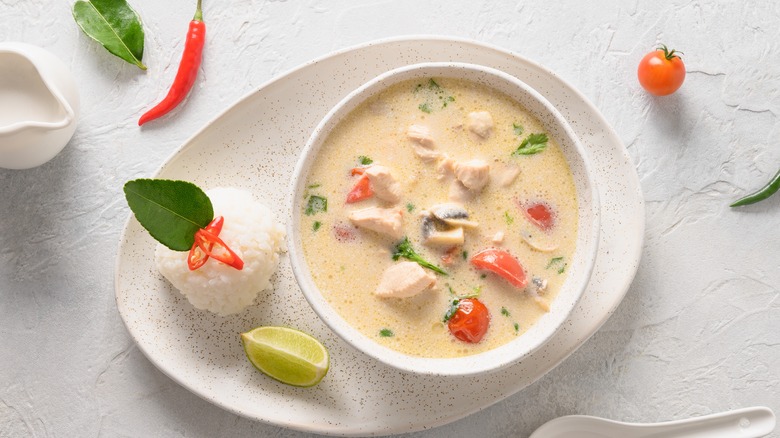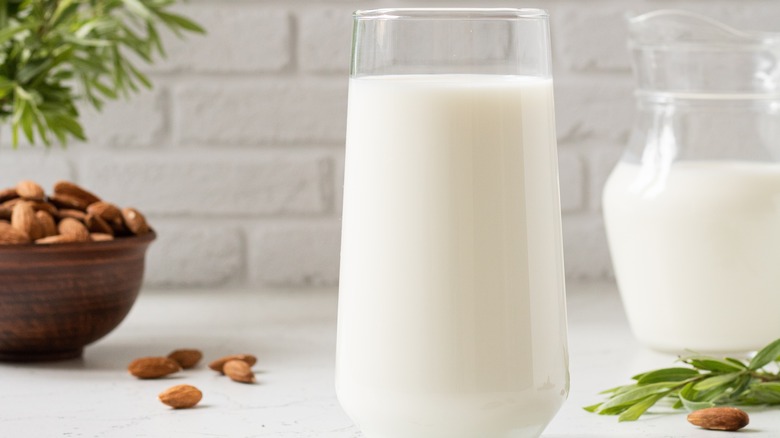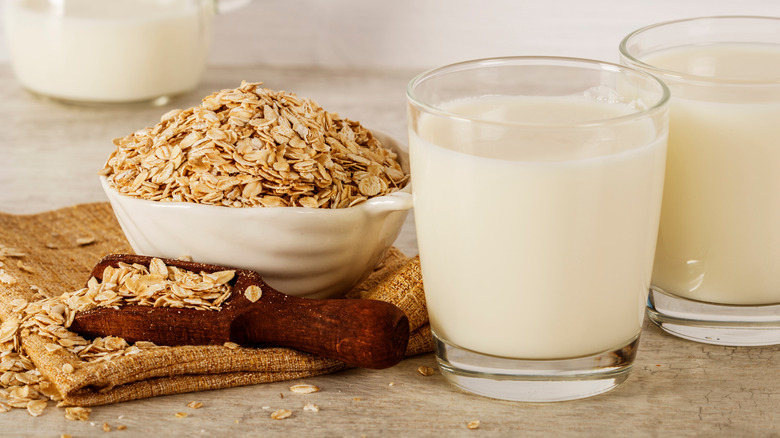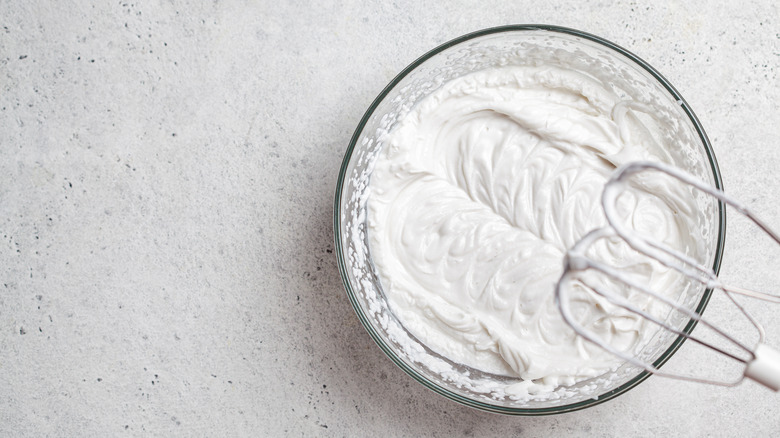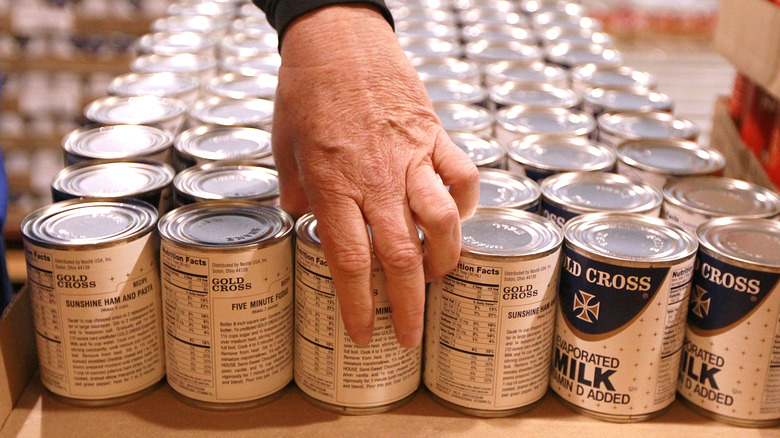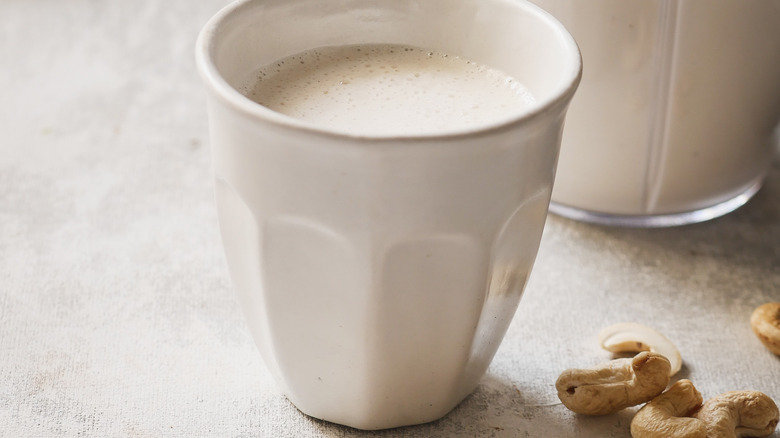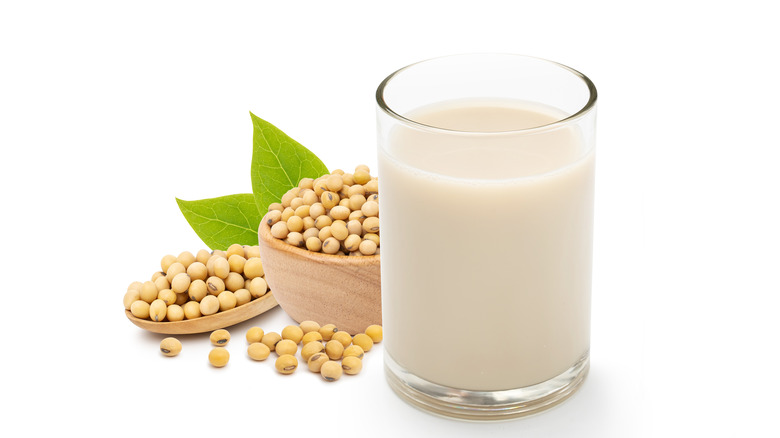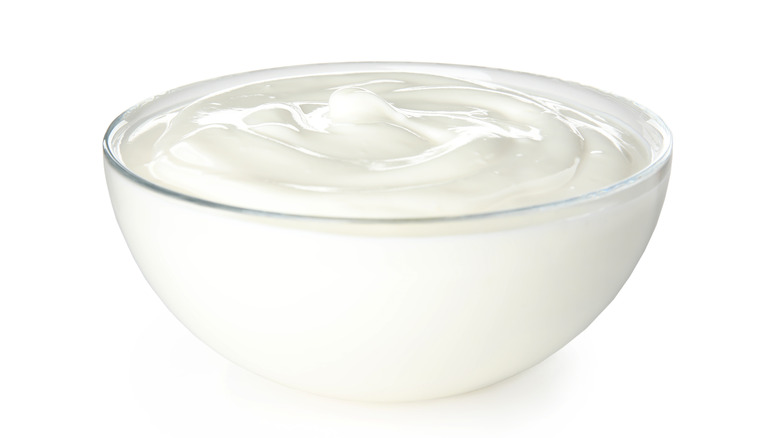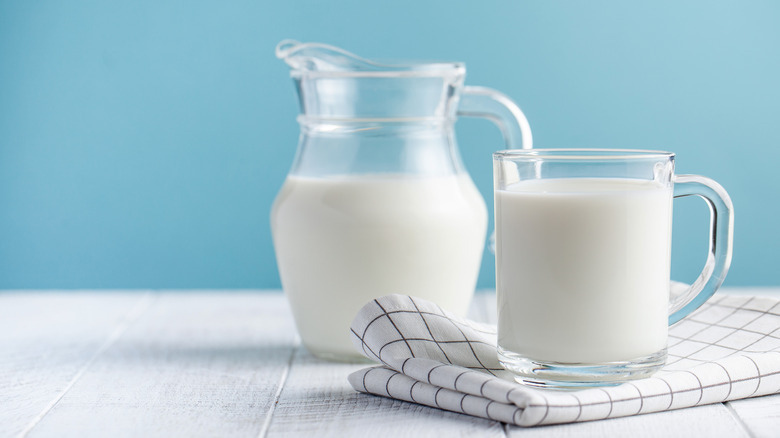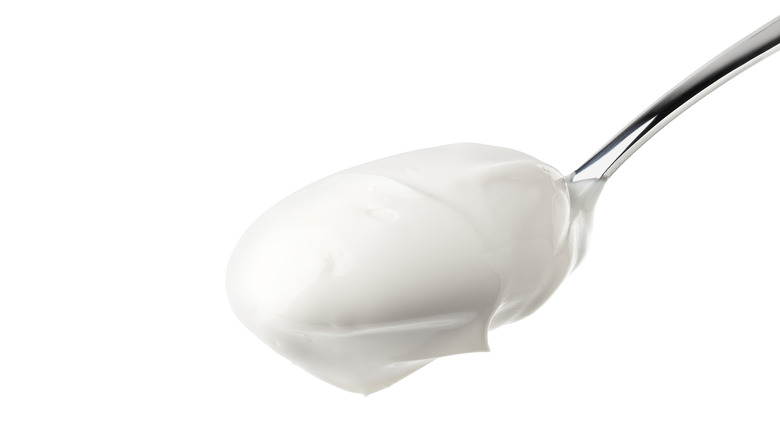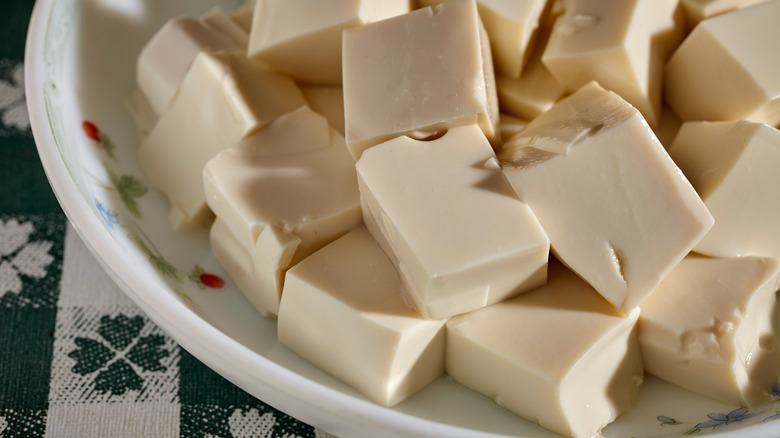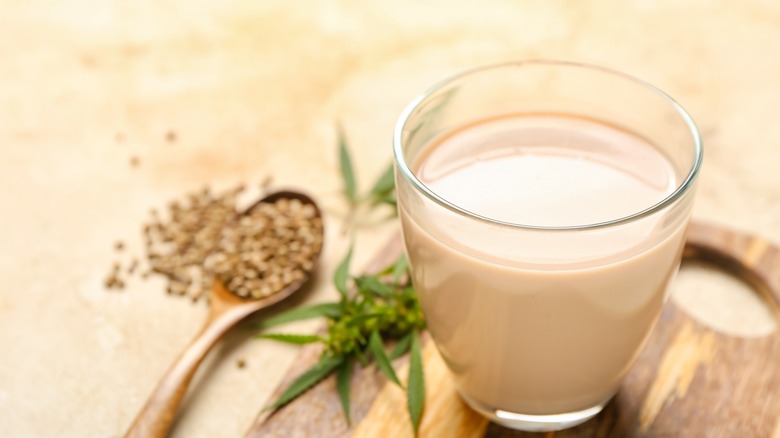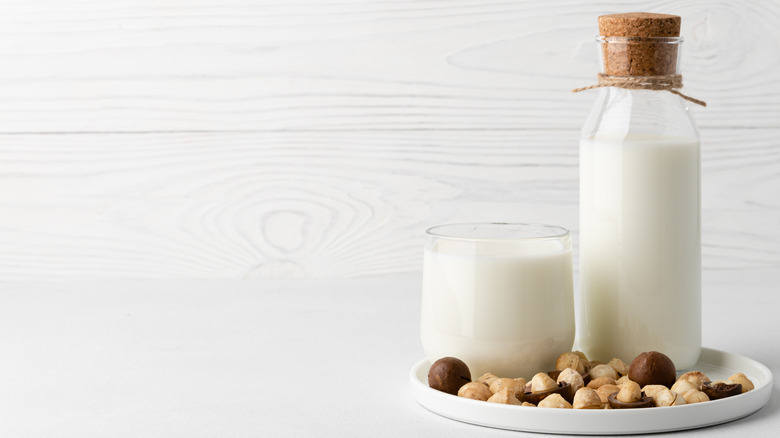13 Best Substitutes For Coconut Milk
If you don't already have a can of coconut milk in your pantry, now is the time to run out to the grocery store and at least pick one up. This humble non-dairy product is made from the flesh of older coconuts blended with water. The resulting liquid is slightly coconut-y but does not have enough flavor to distinguish itself in a latte. Coconut milk is typically used in Asian cuisines as a thickener for soups and stews. It can provide a new flavor dimension and elevate your curry to a new level, whether you're adding seafood, tofu, poultry, or meat. Coconut milk is a popular non-dairy substitute in baking because of its fatty profile and texture. Mixologists can use it in alcoholic beverages as well, including the classic piña colada.
Although you should always have this non-dairy alternative on hand (the cans can keep for months at a time), there comes a time when you might need a substitution. Here are some of our favorite ways to swap out coconut milk in appetizers, entrees, desserts, and more.
Almond milk
Almond milk has surged in popularity in recent years; people have enjoyed its nutritional benefits and relatively low cost compared to other non-dairy beverage alternatives. It also has a nuanced taste that doesn't resemble coconut or oat milk's creaminess. This dairy-free alternative tastes best when used with flavorful drinks — such as lattes or smoothies — because the almond milk can provide bulk without altering the other ingredients. Because it does not have a thickening quality like other coconut milk substitutes, you should avoid using it in soups, stews, and other savory dishes.
If you plan to substitute almond milk for coconut milk, you should purchase the unsweetened, unflavored variety. The sweetened or flavored almond milk variety can make your dish too sweet or off-putting. You should also avoid putting the non-dairy alternative under high-heat conditions because it tends to scald and impart bitter notes if it is overheated.
Oat milk
Oat milk has a significantly creamier texture than almond milk, so it is a more suitable replacement for savory, thicker dishes. However, it contains lower saturated fat than coconut milk (via Plant Based FAQs) — so you won't get the perfect consistency like with a standard coconut-based curry. On the other hand, oat milk is higher in protein and fiber, so it may be a good substitution for people looking to cut down on fat intake and increase satiety after eating.
There are some occasions where oat milk outperforms coconut milk. Baristas will know how easy it is to steam and froth oat milk — to a level almost comparable to dairy milk; per The Green Pods, it froths better than coconut or almond milk because it is loaded with emulsifiers like gellan gum that cause the proteins in the drink to strengthen. Drinkers of oat milk frequently note that it leaves a silky and robust creaminess in the mouth that is not otherwise observed in other non-dairy alternatives.
Coconut cream
Coconut milk and coconut cream may both originate from the same thing, but these two ingredients are vastly different. Coconut cream contains significantly less water than coconut milk. It also has a higher fat content, thus making it easier to whip and fold into soups. If you're working with coconut cream, you should also note that it is not synonymous with cream of coconut, which contains much more added sugars and is commonly used for piña coladas and other tropical beverages. If you want to use coconut cream in place of coconut milk, you should plan to dilute it first. A Couple Cooks suggests combining a ratio of 3 tablespoons of coconut cream to 1 tablespoon of water for ¼ cup of coconut milk.
Coconut cream is an optimal replacement in applications where the dish would benefit from a coconut undertone, such as a spin on The Cheesecake Factory's coconut cream pie cheesecake or just plain coconut cake. You'll get the shining flavor of the drupe in both the cake and the buttercream frosting.
Evaporated milk
Both evaporated milk and condensed milk play a pivotal role in cooking and are commonly used interchangeably in vernacular despite being different. Although both contain very little water and a subsequent concentrated, milky flavor, condensed milk has a ton of added sugar; it's for this reason, it is used as the base for Thai tea and other sweet beverages and treats.
With that said, if you're looking for a substitute for coconut milk, you're better off going with evaporated milk so you won't have to dilute the sweetness or mess with other flavors in your dish. It is a great alternative because of its taste and resistance to curdling in hot temperatures. You can use evaporated milk to thicken soups, stews, and any other application you would normally use with coconut milk. If you plan to use evaporated milk for baking, be sure to dilute the liquid with water to decrease its fat concentration. Alternatively, you can use a low-fat version of evaporated milk commonly sold alongside the standard version.
Additionally, evaporated milk is shelf-stable, so you can stock up on multiple cans and not worry about spoilage for up to a year if they remain unopened.
Cashew milk
Cashew milk is one of the less popular non-dairy substitutes, but the fattiness of the cashew makes this plant-based milk substitute an ideal swap for coconut milk. It can be made at home by adding a cup of soaked, raw cashews to four cups of water and letting it set overnight before draining (via Downshiftology). Mix the combination in a high-powered blender before placing it in the refrigerator to cool. Homemade cashew milk can last up to three days in the fridge, so if you think you'll frequently use it, you might want to stop at the store and get a container of the pre-packaged variety instead.
Cashew milk is best used to replace coconut milk in smoothies and in oatmeal. The flavor is mild, smooth, and deliciously creamy. You should also be aware, though, that cashew milk tends to curdle if placed in a mug with a hot beverage. However, you can counteract this by heating up the cashew milk before pouring it into your coffee.
Heavy cream and whipping cream
Heavy cream is a popular substitute for coconut milk because of its high fat content, and the same can be said for whipping cream. The main difference between the two ingredients is the marginal amount of milk fat. Whipping cream must have between 30% and 35% fat, while heavy cream must contain at least 36% fat. Although the difference may seem trivial, it means that heavy cream is a slightly better option for thickening soups or piping ingredients — like a thick, whipped frosting — that retain their shape.
According to Jamie Geller, almond and oat milk cannot reach the same creaminess level as heavy cream. Therefore, heavy cream is the preferred substitute when you need a lot of fat in a recipe (such as a creamy vichyssoise soup). Geller notes you can substitute coconut milk and heavy cream with a 1-to-1 ratio for a dish.
Soy milk
Soy milk is a common non-dairy alternative found in the grocery store. Although the product was introduced to American audiences in the 1980s, it has had a long history in Asian countries where the beverage is commonly served by the glass. Soy milk is a low-fat option compared to coconut milk and contains a healthy dose of calcium. For folks looking to make their own soy milk at home, you'll just need to combine dried soybeans with water, pulse, and strain.
Soy milk places in the middle of the race for the creamiest substitute for coconut milk — it is thicker than almond or oat milk but not as rich as heavy cream or evaporated milk. Like other store-bought, dairy-free alternatives, you should check the label to ensure the soy milk you purchase is unflavored and unsweetened before mixing it into cold coffee. According to Coffee Addiction, soy milk will curdle in coffee, soups, and other hot dishes and drinks because lactic acid impacts the milk's protein content.
Greek yogurt
The fatty and thick texture of Greek yogurt might not make it the first substitute that comes to mind, but this dairy-based product replicates the same tang, flavor, and smoothness of coconut milk.
If you add Greek yogurt directly to a recipe rather than diluting it first, the resulting texture may scare you a bit. To avoid this, try mixing it with a tablespoon or two of water. If you want a more liquid consistency, add more water. Moreover, if you need to replicate the same taste coconut milk provides, look for coconut-flavored Greek yogurt in the dairy aisle at your grocery store. You should also try to purchase Greek yogurt that contains very little added sugars to avoid altering the other ingredients in your dish.
Can you use plan yogurt instead? If you want to substitute coconut milk in a recipe, you should use Greek yogurt rather than plain yogurt. The former contains three times as much saturated fat as plain yogurt and much more protein.
Whole milk
Since we've covered other non-dairy products, what about the simplest dairy product of all — milk? According to the Auguste Escoffier School of Culinary Arts, you can use a one-to-one ratio to substitute whole milk for coconut milk (and vice versa). If your recipe specifically requires full-fat coconut milk, you should use a whole-fat or heavy cream substitute rather than skim milk. This will result in the most similar texture to the original ingredient.
Using whole milk as a substitute for coconut milk in baking is ideal. The Auguste Escoffier School of Culinary Arts notes that you will not need to alter the baking temperature or time if you swap whole milk for coconut milk. Since milk rarely contains sweeteners (unless you opt to purchase chocolate milk or another flavored milk), you won't have to alter the sweetness of other ingredients in the recipe. You also don't have to worry about curdling if you're cooking with milk.
Sour cream
Sour cream is a common ingredient for baked potatoes and dips, but how does it size up as a replacement for coconut milk? Sour cream contains a minimum of 18% fat, so it will easily replace the fatty flavor of coconut milk. However, some folks refrain from adding it as a replacement for other ingredients because of its sour taste — a byproduct of lactic-acid bacteria breaking down milk proteins.
It is more acidic than yogurt, so you should add it to a dish sparingly and taste it frequently while cooking — as if you needed an excuse. The FoodsGuy recommends using sour cream in curries because its flavor can balance the heat from both spicy and sweet versions. You can also add buttermilk for even more tang. However, you need to be careful of how much of the ingredient you add to avoid splitting the cream and ruining your dish.
Silken tofu
Silken tofu is unlike other tofu varieties floating around in your curry or vegetable stir-fry. It is a soft, custardy ingredient made by combining curdled soy milk with magnesium chloride. The result is a type of tofu that breaks easily and can be pureed down into a smooth, creamy base for sauces and vegan chocolate mousses. Other tofu types (like firm or extra firm tofu) cannot be used as a substitute for coconut milk because they will not be able to form a custard when blended as easily.
In a recipe, you can substitute 1 cup of pureed silken tofu for 1 cup of cream. If you want to mimic coconut milk's texture more accurately, try pureeing silken tofu with equal parts soy milk to replace it.
There are many nutritional benefits to substituting silken tofu for coconut milk. Most notably, it is a powerful source of protein for plant-based eaters. It contains lower fat than coconut milk and more calcium, which contributes to strong bone development.
Hemp milk
Hemp milk is made from soaked hemp seeds. Its taste is undoubtedly earthy, so it might not be an ideal substitute for all palates. Moreover, since the flavor is more powerful than an almond or an oat milk substitute, you should stick to using it for foods that can use a nutty boost, like oatmeal or cereal, rather than curry or creamy soup. You can swap out coconut milk for hemp milk at a one-to-one ratio.
Hemp seeds come from the hemp plant (Cannabis sativa). But despite their botanical connection to the THC-containing plant, the seeds actually do not contain bioactive hallucinogens or residue that will show up positive on a drug test (via Chef Soraya). Both the seeds and milk are safe for children or breastfeeding people to consume. In fact, eating hemp seeds have a positive impact on nutritional well-being because of their high-quality protein, magnesium, and both soluble and insoluble fiber.
Macadamia nut milk
We're going nuts for macadamia nut milk! According to Planted, this non-dairy alternative is made by soaking the raw macadamia nuts in water before pureeing and straining. The nuts carry many positive nutritional benefits, including fiber, protein, manganese, thiamin, and copper. You can find macadamia nut milk in the shelf-stable milk aisle with other non-dairy-based products like almond milk.
Both macadamia nut milk and hemp seeds are on the fattier end of the plant-based milk spectrum. The result is a creamier base that resembles the texture of heavy cream or coconut milk. Unsweetened macadamia nut milk contains no added sugars, so you are free to substitute macadamia nut milk for coconut milk using a one-to-one ratio. We recommend adding it to vegan ice cream or using it as a thickening agent for various sauces. You likely won't be able to tell the creaminess results from macadamia nuts!
